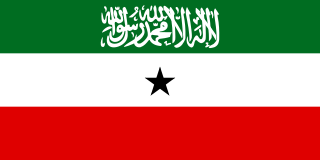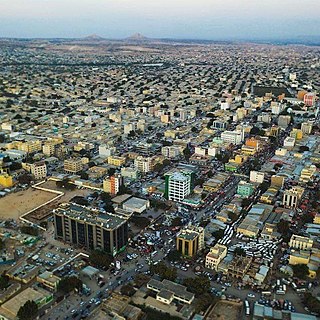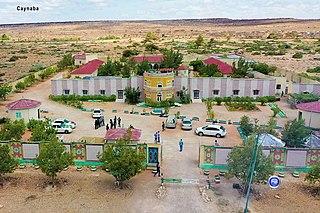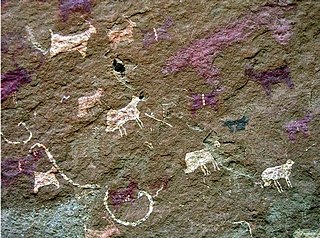
Somaliland, officially the Republic of Somaliland, is an unrecognised state in the Horn of Africa, recognised internationally as a de jure autonomous region of Somalia.

In archaeology, cave paintings are a type of parietal art, found on the wall or ceilings of caves. The term usually implies prehistoric origin, and the oldest known are more than 40,000 years old and found in the caves in the district of Maros. The oldest are often constructed from hand stencils and simple geometric shapes. More recently, in 2021, cave art of a pig found in Sulawesi, Indonesia, and dated to over 45,500 years ago, has been reported.

Sanag is an administrative region (gobol) in north eastern Somaliland. Sanaag has a long coastline facing the Gulf of Aden to the north, and is bordered by the region of Sahil to the west, Sool to the south and Somalia to the east. The region is disputed by the self-declared Republic of Somaliland and Puntland, a Federal Member State of Somalia. Its capital city is Erigavo. Sanaag is the largest region of Somaliland, accounting for 35% of Somaliland's total land area.

Hargeisa is the largest and capital city of the self-declared Republic of Somaliland, a de facto sovereign state in the Horn of Africa, which is still considered internationally to be part of Somalia. It is also the regional capital of the Maroodi Jeex province of Somaliland.

The history of Somaliland, a country in the eastern Horn of Africa bordered by the Gulf of Aden, and the East African land mass, begins with human habitation tens of thousands of years ago. It includes the civilizations of Punt, the Ottomans, and colonial influences from Europe and the Middle East.

The Economy of Somaliland largely relies on primary production and agriculture, where livestock is the main export of the country, which it ships to neighbouring Djibouti and Ethiopia, as well as to Gulf states, such as UAE, Saudi Arabia and Oman. Somaliland has a GDP per capita of $681 and a gross domestic product GDP of $3,065,102 as of 2022, most of which it receives in remittances from Somalis working abroad. The COVID-19 pandemic has restricted Somaliland's trade flows with decreased demand in the agriculture sector, a significant source of tax revenue.

Laas Geel, also spelled Laas Gaal, are cave formations on the rural outskirts of Hargeisa, Somaliland, situated in the Maroodi Jeex region of the country. They contain some of the earliest known cave paintings of domesticated African aurochs in the Horn of Africa. Laas Geel's rock art is estimated to date to circa 3,500-2,500 BCE.
Aw-Barkhadle is a town located near Hargeisa in modern-day Somaliland. It was part of the Muslim empires in the Horn of Africa during the middle ages and served as the capital of the Adal Sultanate. It was also the burial place for many of the local leaders including the rulers of the Walashma dynasty that governed the Ifat and Adal Sultanate and kingdoms. Prior to that it was a very important pre-Islamic center.
El Afweyn is a town in the Sanaag region of Somaliland.

Aynaba, also spelt Ainabo, Ainaba or Aynabo is a major town in western Sool region of Somaliland as well as the administrative seat of the Aynaba District. Aynaba is known for its watering wells and for its good and abundant fresh water.

El Ayo, also known as El Ayum, is a coastal town in the eastern Sanaag region of Somalia, near the border with Somalia. There is a base of the Puntland Maritime Police Force, which is effectively controlled by Puntland.
Tourism in Somalia is regulated by the Federal Government of Somalia's Ministry of Tourism. The industry was traditionally noted for its numerous historical sites, beaches, waterfalls, mountain ranges and national parks. After the start of the civil war in the early 1990s, the Tourism Ministry shut down operations. It was re-established in the 2000s, and once again oversees the national tourist industry. The Mogadishu-based Somali Tourism Association (SOMTA) provides on-the-ground consulting services.
Tourism in Somaliland is regulated by the Somaliland's Ministry of Tourism.

Somali nationalism is centered on uniting the Somali people who share a common language, religion, culture and ethnicity, and as such constitute a nation unto themselves. The ideology's earliest manifestations in the medieval era are traced to the Adalites whilst in the contemporary era its often traced back to SYL, the first Somali nationalist political organization to be formed was the Somali National League (SNL), established in 1935 in the former British Somaliland protectorate. In the country's northeastern, central and southern regions, the similarly-oriented Somali Youth Club (SYC) was founded in 1943 in Italian Somaliland, just prior to the trusteeship period. The SYC was later renamed the Somali Youth League (SYL) in 1947. It became the most influential political party in the early years of post-independence Somalia. The Somali guerilla militia Al-Shabab is noteworthy for incorporating Somali nationalism into its Islamist ideology.

Sada Mire is a Swedish-Somali archaeologist, art historian and presenter from Arap clan who currently serves as an assistant professor at the faculty of archeology, Leiden University. She is a public intellectual and heritage activist who has argued that cultural heritage is a basic human need in her 2014 TEDxEuston talk. In 2017, Hay Festival of Literature and the Arts selected Mire as one of their 30 international thinkers and writers. She became the Director of Antiquities pf Somaliland in 2007. Raised in the Somali capital of Mogadishu, Mire fled the country at the start of the civil war at the age of 15. She then traveled to Sweden seeking asylum. She has since returned to the Horn of Africa as an archaeologist.

Dhambalin is an archaeological site in the central Sahil province of Somaliland. The sandstone rock shelter contains rock art depicting various animals such as horned cattle and goats, as well as giraffes, an animal no longer found in the country. The site also features the earliest known pictures of sheep in Somaliland. Discovered in autumn 2007, residents of Beenyo Dhaadheer reported the rock art to the Somali archaeologist Sada Mire, Director of the Department of Archaeology within the Ministry of Tourism and Culture of Somaliland.
Karinhegane is an archaeological site in the eastern Sanaag region of Somaliland. It contains some unique polychrome rock art.

Gaanlibah or Ga'an Libah is mountain range, archaeological site, and national park located in the Maroodi Jeex region of Somaliland. Nearby are the Golis Mountains. Its upper slopes are the source of the seasonal Togdheer river that flows through the city of Burao into the Nugaal Valley.
Gudmo Biyo Cas is a town located in the Sanaag region of Somaliland. It is the site of numerous archaeological structures and rock art.

Dhaymoole is an archaeological site in the Sahil province of Somaliland. The site is a cave that contains a collection of ancient rock drawings showing a variety of animals as well as some unidentified symbols. These drawings were created during the third millennium BC.




















